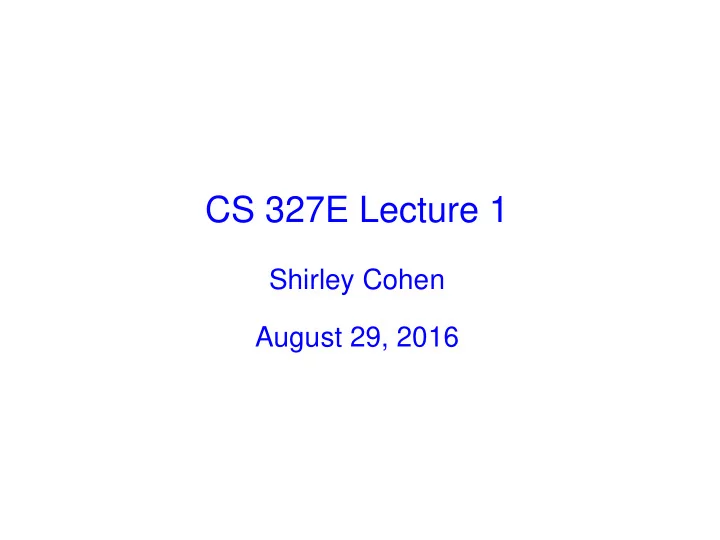

CS 327E Lecture 1 Shirley Cohen August 29, 2016
Reminders • Homework: assigned chapters from modeling book • Short quiz based on assigned chapters • Register your clicker and bring it each time
Heads-up on Lab 1 • Choose structured datasets (csv, xml, json, etc.) • Choose lab partner • Design a database schema • Lab days: 09/19 and 09/21, due: Friday, 09/23
Question 1: What makes a good data model? A. Completeness B. Non-Redundancy C. Enforcement of Business Rules D. Data Reusability E. All of the above
Question 2: Since data modeling costs a lot of money, businesses should try to avoid it as much as possible A. True B. False
Question 3: An entity class is a real-world class of things A. True B. False
Question 4: A good strategy for developing ER diagrams is to model from: A. Top-down B. Bottom-up C. Inside-out D. All of the above
Key Concepts A data model is a collection of concepts for describing data. A schema describes the structure of the data for a given data model.
Key Concepts • Relation / Entity Class / Table • Field / Attribute / Column • Row / Entity / Tuple / Record • Cell / Value Primary key • Primary key • Composite primary key • Foreign key • Constraint Foreign key
Key Concepts Entity Class = an object of interest Attribute = property of an entity Relationship = association between one or more entity classes Relationship types: • one-to-one: • one-to-many: • many-to-one: • many-to-many:
ERD Example #1 Credit: No Comment Team, CS 327E Spring 2016
ERD Example #2 Credit: Oxfam Team, CS 327E Spring 2016
ERD Example #3 Credit: MDGA Team, CS 327E Spring 2016
ERD Example #4 Reference: http://tinyurl.com/z6t6qs4
Data Dictionary Reference: http://tinyurl.com/z6t6qs4
ERD Exercise #1
Constraint Types • NOT NULL constraint • Unique constraint • Primary and foreign key constraint • Check constraint
Common Data Types • CHAR and VARCHAR • INTEGER • FLOAT • DATE and TIMESTAMP • BLOB and CLOB
Design Tips • Tip 1. Best order of modeling: 1-entity classes, 2-relationships, 3- attributes. • Tip 2. Keep ER diagram to one page. If necessary, separate into views. • Tip 3. Accompany diagram with data dictionary to explain important entity classes, relationships, and attributes. • Tip 4. Deal with lack of information and pressing timelines. Use creativity to find a solution.
ERD Exercise #2
Resources • Lots of common entity types (e.g. Customer, Product, Event, etc.): http://schema.org • ER diagramming tools: MySQL Workbench and LucidChart • Survey paper: J. Hellerstein and M. Stonebraker. "What Goes Around Comes Around” in Readings in Database Systems, 2004. • Supplemental book: Andy Oppel’s Data Modeling A Beginner’s Guide (2009).
Homework for Next Time • Read Chapter 4 from our Data Modeling textbook
Recommend
More recommend